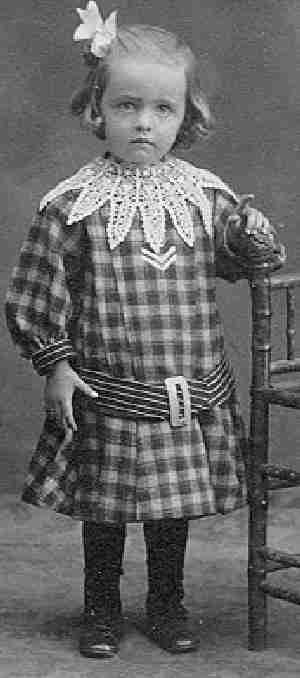difficult images: gender #10

Difficult Images: Gender #10

Figure 10.--While most would say that this child is definitely a girl, HBC is not so convinced. The tunic outfit has no girlish touches except the lace collar, which of course many boys wore. There is also a prominentbelt. Thus it definitely could be a boy. Click on the image for a fuller discussdion.
|
Most would say that this child is definitely a girl, especially because of the hair bow. HBC is not so convinced. And in fact considers this to be a tough image to assess. The child definitely could be a boy, but there is no way of knowing for sure. The tunic outfit has no girlish touches except the lace collar, which of course many boys wore. There is also a prominent belt. Thus it definitely could be a boy.
Chronology
In assessing images, it is always hrlpful to date it. HBC believes that this images was taken in the 1890s, probably the late 1890s, or eraly 1900s. This was when the tunic suits this child is wearing were most common. Also the matting of the carte d'viste looks like a late 1890s or early 1900s card.
Hair Bows
The child's hair bow in particular would lead many to conluse this child is a girl. HBC has noted, however, that some boys had hair bows added to their curls--even boys much older than this child. Thus the hair boy does mot rule
Curls
The curls also suggest to many that the child is a girl. But as HBC has noted many boysm even older boys, had long hair in the late 19th century. Some even wore ringlets. So the hairvdoes not rulke out a boy.
Tunic
Many would say the child is swearing a dress. HBC believes it is a tunic. Tunics were widely worn by boys fron abour 2-6 or 7 years of age at the turn of the century. Also notice that except for the lace collar their are no fancy or girlist emberlistments to th tunic. HBC speculates that this child would have been dressed in his or her best outfit for a formal portrait. Wouldn't a girl have a fancier outfit? This might have been a boy's best outfit, but probably not a girl's party dress.
Pattern
Notice the tartan-like pattern of the tunic. Many sych tunics forvboys were solid colors. The most common pattern was tartan, suggesting a boy-like kilt.
Belt
HBC notes that belts were more likely to be used on boys' tunics andc dresses than girls'. It is not that belts were never employed on girls' clothes--but usually not as prominetly.
Lace Collar
Lace cpllars were often used on boys' clothes--most prominely Fauntleroy suits. In fact large lace collars were more commonly usedcon boys' outfits than girls. HBC is not yet sure about the gender conotations about lace collar patterns.
Age
This child us quite young, operhaps 3 years old. Many children of that age were not breeched until 5 years of age or older in the 1890s.
Comments
A HBC contributor reports, "I never see contemprary fornmal portraits that had girls with belts and long sleeves. The collar I've seen on both boys and girls."
Christopher Wagner

Navigate the Historic Boys' Clothing Web Site:
[Return to the Main difficult gender page]
[Introduction]
[Activities]
[Bibliographies]
[Chronologies]
[Contributions]
[Frequently Asked Questions]
[Links]
[Style Index]
[Boys' Clothing Home]
Created: June 12, 2000
Last updated: June 12, 2000


